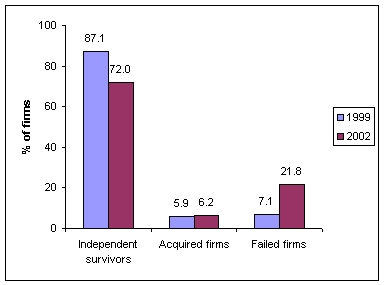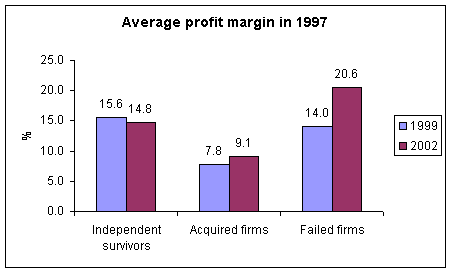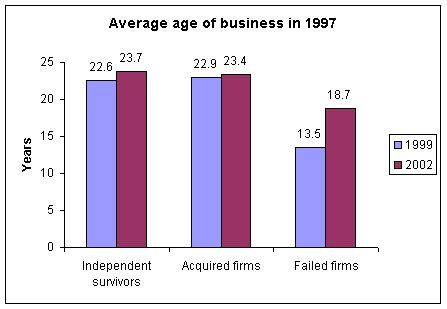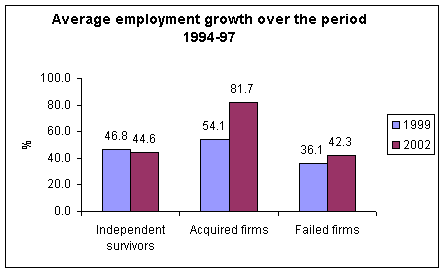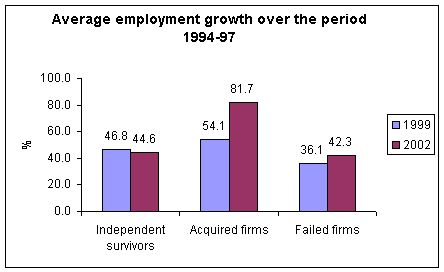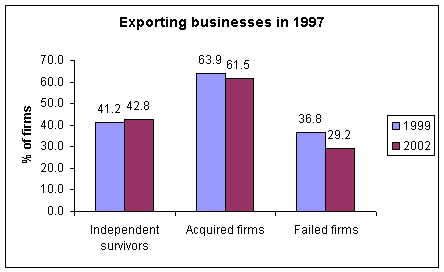Learning from Enron; what makes entrepreneurs tick; and the saga of Britain’s managerial skills shortage…
17 October 2003
Why we might be learning the wrong lessons from the collapse of Enron; what Britain’s high-tech entrepreneurs are really like; and the curious, post-War history of why institutional investors began buying shares in UK companies at a time when the skills of the managers running them seemed seriously inadequate…
These are just three of the issues raised in new Working Papers published this week by the Centre for Business Research (CBR) at the University of Cambridge.
The seven papers raise a number of issues for policy-makers in the fields of enterprise, and corporate governance. These range from warning that high-tech small firms cannot be treated identically, since they do not all follow the same growth paths and ambitions, to urging policy-makers to consider very carefully the real lessons of the collapse of Enron.
After interviewing a number of high-tech entrepreneurs, the authors of The Beer Beneath the Froth (Working Paper 272) are warning industrial policy-makers not to get carried away with the idea that every small high-tech by usiness is set up by an ambitious young graduate with their eyes on fast growth, a quick profit and a rapid exit.
“The number of such businesses is small,” says CBR Research Fellow Dr Thelma Quince. “And to focus too narrowly on their needs and problems may distort policy such that the majority of small high-tech firms are overlooked.” Dr Quince, who co-authored the research with Professor Hugh Whittaker, interviewed the entrepreneurs who set up 25 high-tech firms. The popular model for such businesses, she says, is that of a University spin-out with young academic founders, supported by venture capitalists, and aiming for a few years’ fast growth, followed by the sale or flotation of the company.
But Dr Quince said that in her interviews, she found very few firms like this. “Most high-tech CEOs I talked to said, ‘We don’t fit the model’”, she says. “Yet these companies were involved in high value added activities, operating in global markets, making a real economic contribution.”
Despite a prevailing view that high-tech entrepreneurs are relatively young academics or researchers, only five of the firms Dr Quince studied were set up by people in their twenties. Among the rest, seven were founded by people in their forties, and three by people in their fifties. And few of them were driven largely by the prospect of financial gain. She found that they tended to be motivated by a number of factors, often including the satisfaction of solving creative and intellectual challenges, and the pleasure they got from seeing their employees working together as a team to make something happen.
She concludes, there is a need for both policy-makers and members of the public to recognise the importance and concerns of existing high-tech firms like this – who represent the main body of the ‘beer’ – and not to be blinded by the attractions of the ‘froth’.
A much larger business is the focus of Working Paper 274 – Learning from Enron. CBR researchers Simon Deakin and Suzanne Konzelmann have studied the policy responses to the record collapse of the US energy giant in 2001, and argue that policy-makers have got it wrong. “The Enron affair has been misunderstood as a failure of monitoring”.
The authors say that US legislators have mistakenly assumed that Enron’s downfall was brought about by conflicts of interest on the part of its senior managers, and by a lack of oversight on the part of its board and advisors. This is why the Sarbanes-Oxley Act, enacted in the summer of 2002, imposes rules aimed at enhancing the independence of directors and auditors.
However, the authors claim, these conflicts of interests were incidental to the company’s failure. The real problem “was the failure of Enron’s board of management to take responsibility for the risks inherent in the company’s business plan – and the misuse of certain forms of off-balance sheet financing.” The problem was that these were very complex and hard to understand. “Whatever else their failings,” say the researchers, “Enron’s non-executive directors were as well qualified as almost any group of outsiders could have been to judge the regulatory and business risks which arose from the company’s business. That they failed to do so is testimony to the complexity of the monitoring task.”
They add that the new Act, which makes board directors more independent, is not necessarily the answer. In deregulated and liberalised markets where “the risks of competitive failure by listed companies are greater than they have ever been”, they conclude, “non-executives are in an unenviable position. When companies fail, they will increasingly be held accountable; but as outsiders, they will often lack the knowledge and experience to have made a difference.”
Meanwhile Working Paper 268 on The Separation of Ownership and Control traces the history of how between the 1950s and 1980s Britain’s firms moved from being largely family owned, to having highly diverse public ownership. This is all the more curious, says author Professor Brian Cheffins, at a time “when serious doubts existed about the quality of British managers”, and there seemed to be very little incentive to outsiders to invest in the firm.
In his study of the change in ownership patterns, Professor Cheffins not only quotes contemporary commentators on the change, one of whom equates British managerial practices in the 1970s with those of the Soviet Union (!). But he also traces many other factors – including the way inflation rates reduced the popularity of fixed-income investments, and the expansion in world trade during the 1950s and 1960s – that made investing in UK companies look attractive.
High-level representatives attend CBR conference
11 August 2003
Around 60 delegates came to the CBR’s “Enterprise Challenged” conference on June 25th, to hear CBR staff unveil the results of their latest, large-scale survey of Britain’s smaller firms.
Among the attendees hearing findings from the survey – entitled “Enterprise Challenged: Policy and performance in the British SME sector
1999-2002” – were representatives from the DTI, the Small Business Service, the Inland Revenue, Barclays, the Bank of England, and the Federation of Small Businesses.
The survey, a study of more than 2,000 small and medium-sized firms up and down the UK, covered a number of important issues. These include the constraints and the nature of the competition small firms face, their ability to recruit and retrain staff, and the differing performances by urban firms versus their regional counterparts.
There was also a presentation by the survey’s co-editors Dr Andy Cosh and Professor Alan Hughes on firms’ innovation activity. This showed that the proportion of firms engaging in research and development (R&D) had fallen since 1997, and the number of firms employing full-time R&D staff had also fallen – in manufacturing, for example, from 23 per cent of firms in 1997 to only 16 per cent in 2002.
In fact, the report shows that the number of full-time R&D staff have fallen while the numbers of part-time staff have risen. This, taken with other findings, suggests that firms in future are aiming to innovate while yet committing less expenditure to R&D. This, Cosh and Hughes argued, is at odds with the policy objective within the EU of encouraging firms to raise their ratio of R&D expenditure to sales, so that it matches the levels found in the US.
CBR researcher wins conference award
21 July 2003
A CBR researcher’s study of Britain’s high-tech entrepreneurs won an award at this year’s World Conference of the International Council for Small Business.
CBR Research Fellow Dr Thelma Quince won ‘Best Paper’ award in the session on ‘Hi-growth and hi-tech business development’ at the conference in Belfast in June.
She was reporting on her case studies of 25 high-tech firms, which she characterises as “steady blokes and beer, not young dudes and froth”.
In her paper, ‘The Beer beneath the Froth’, she pointed out that there is currently much policy interest in encouraging small, high-tech firms to spin out of universities. But she warned that we should keep our interest in them in perspective.
“The number of such businesses is small,” Dr Quince says, “and to focus too narrowly on their needs and problems may distort policy such that the majority of small high-tech firms are overlooked.”
Dr Quince has been interviewing CEOs of high-tech firms about their motivations, their collaboration with the research base, and their experience of venture capital
The popular model for high-tech firms, she says, is that of a University spin-out with young academic founders, supported by venture capitalists while it develops its ‘product’. The firm aims for a few years’ fast growth, and the founder hopes then to make money by selling or floating the company.
But Dr Quince said that when she went out to interview high-tech CEOs, she found very few firms actually like this. “Most high-tech CEOs I talked to said, ‘We don’t fit the model’, or ‘We’re not doing business properly’, “ she says. “Yet these companies were involved in high value added activities, operating in global markets, making a real economic contribution.”
Despite a prevailing view that high-tech entrepreneurs are relatively young academics or researchers, only five of the firms Dr Quince studied were set up by people in their twenties. Among the rest, seven were founded by people in their forties, and three by people in their fifties.
Many had set up firms in collaboration with others, rather than on their own; and had either set up more than one firm, or had seen the business pass through a number of stages.
Few of them were driven largely by the prospect of financial gain. She found that they tended to be motivated by a number of factors, often including the satisfaction of solving creative and intellectual challenges, and the pleasure they got from seeing their employees working together as a team to make something happen.
And though in the popular model, high-tech businesses are supported by venture capitalists, the entrepreneurs Dr Quince interviewed were largely negative about them. “They saw venture capitalists as exploitative, having a short-term orientation, and a superficial view of technology, ” she says.
In conclusion, she says, “The model sees enterprises established within a relatively short time frame, and emphasises material rewards, rapid growth and equity funding through venture capital.
“Whereas the case studies reinforce the view that high-tech enterprise is iterative and collaborative; and that personal relationships with customers, collaborators and venture capitalists are very important: the extent to which the visions were shared, and technology truly understood, were important factors in respect of venture capital.”
She concludes, there is a need for both policy-makers and members of the public to recognise the importance and concerns of existing high-tech firms like this – who represent the main body of the ‘beer’, and not be blinded by the attraction of the ‘froth’. “Improving the UK’s international competitiveness depends on high-tech venture creation and on the health of existing high-tech firms, including small firms,” she says.
Small business failures rise, but owners who invest in their firm are more likely to cash out
2 June 2003
The rate of failures among Britain’s smaller firms has increased significantly in the last three years – according to a major new survey by the Centre for Business Research at Cambridge University. “Enterprise Challenged”, a large-scale study of small and medium-sized businesses up and down the country, shows that between 1997 and 1999, the rate of failures was just 7.1 per cent. But between 1999 and 2002, it shot up to 21.8 per cent – three times the previous level.
The survey found that smaller, newer firms, which carried out less training, and innovated less, were more likely to fail. But firms that invested in training, innovation and exports to grow the business, were more likely to have been successfully sold on to other businesses.
Interestingly, our analysis of the failures shows that there was no indication from their profitability that they were going to fail – implying that they are vulnerable to sudden shifts in fortune, eg the decision by a major customer to withdraw a contract. Whereas, the acquired firms ploughed the money back into the business and hence had lower profit margins – 8% in 1997-99 and 9% in 1999-2002 – than those firms that subsequently failed.
“Enterprise Challenged” is the latest in a continuing series of surveys by the influential Centre for Business Research which maps the fortunes of a panel of two thousand firms from manufacturing and business services. The survey also finds:
That those successfully acquired firms were more often in manufacturing, while the firms that had failed were more likely to be in the business services sector. In 1999, failed firms were on average nine years younger – and in 2002 those that had failed were on average five years younger – than survivors.
In 1997, the firms that were subsequently acquired were larger and were increasing their employment at a higher rate than either the surviving independent businesses or indeed the failures.
They were also more innovative – 81% for the acquired in the period 1999 to 2002, up from 77% in the earlier period 1997-99. By contrast the proportion of innovators in failed firms went down from 62% to 57% over the same period.
More acquired businesses were exporters – 62% as opposed to 29% for failed businesses, with 43% of surviving independent firms exporting.
Britain’s smaller companies wish for lower tax rates, less regulation – and fewer politicians
26 May 2003
If given a magic wand, and allowed to wish for one policy change that would help them most, a third of the owners of Britain’s smaller firms would ask for a reduction in tax and national insurance rates.
Their second wish would be for the government to cut the burden of red tape and bureaucracy. And with their third, they’d ask for more government support for small businesses, according to “Enterprise Challenged”, a major new survey of 2,000 small and medium-sized enterprises (SMEs) up and down the UK.
The research – to be published on 25 June 2003 by the Centre for Business Research at Cambridge University – is an in-depth panel survey of companies ranging in size from one to 500 employees. It looks at their behaviour, performance and profitability over the last three years, and it studies the constraints affecting these firms (notably increased competition, and a skills shortage in the workforce).
In one part of the study, respondents were asked which existing government policies had most helped, and most hindered, their businesses – and which policies they would most like to see introduced.
30 per cent of respondents named changes to tax and national insurance as an area of legislation where they would like to see changes. A further 20 per cent wished for a cut in the burden of red tape on small firms. And 23 per cent of them named employment legislation as the area of legislation that had caused them most problems.
Many of those who wished for changes to tax and national insurance asked for both personal and business tax rates to be reduced for entrepreneurs, for the tax burden on rural firms to be cut, and for tax and NI rules to be made simpler.
One respondent wished for “less tax & NI contributions”, adding, “We could afford to employ someone else if this was reduced by a half to a third.”
Another suggested there was a need for “a growth sensitive tax structure. Growing companies make profits but need masses of cash. I suggest, if companies increase employment by 10%+ in a year, nil corporation tax should be payable.”
A further 20 per cent of them wished for a cut in the burden of red tape and bureaucracy on small firms.
One respondent commented: “The continual waterfall of new regulations, and paper pushing, means that on average, two days per week are spent on new legislation implementation.”
A respondent at another small business wished for “…a lot less rules, regulations and EU law, which have to be enacted by really small business like ours.” The respondent added: “ We are seriously thinking of getting out of the labour market within two years, as it’s too much hassle to employ people. There’s too much legislation, small return, and no recognition of how much employment really small firms provide.”
When small companies were asked about the government policies they felt had hindered them most over the last 10 years, the responses were extremely negative. Changes to employment legislation and were among the least popular, being cited by 23 per cent of businesses.
One respondent echoed the feelings of many when he wrote that: “(Current) employment laws make letting go of ineffective staff very difficult”.
Another employer complained that having to comply with current Employment legislation, as well as with health and safety, planning, fire, VAT and Inland Revenue requirements, meant that: “ There are now more regulations than do-ers”.
Meanwhile, one respondent – when asked about the policy that had most hindered his business – replied pessimistically: “Progress in general…”
When asked about policy changes that small companies most wished to see introduced, the answers ranged quite widely. As well as changes to tax and red tape, it also included:
“A halt to the increasing moves to make a company responsible for the morality, social actions, and lifestyle of its employees (e.g. in areas of maternity/paternity, email, language and behaviour). A company should participate in these areas, but final responsibility (including consequences) should stay with the individual.”
and:
“(Changes to the) availability of labour and housing. At present,” said one respondent, “I am simply unable to pay workers enough to live, that is unless their wives have an income at least equal the husbands.”
But some of the replies were very negative. One respondent said:
“No policy decisions would go far enough to change my present view that the sooner I can get out of running a business the better off I’ll be.”
And another simply said he wished to:
“Shoot the politicians.”
Such pessimistic responses do not entirely surprise the CBR’s Dr Andy Cosh, co-editor of “Enterprise Challenged”. He says, “There have been many changes to employment laws over the last few years, including the introduction of the minimum wage, implementation of EC working time directives, the introduction of stakeholder pensions, and increases in NI contributions.
“This has increased the administration involved in employing staff, and – firms feel – made it more difficult for them to dismiss inefficient workers. So it is not surprising that many business owners and managers are seeking a cut in red-tape, and that almost a quarter of the firms named employment legislation as the policy that has hindered them most.”
Shortage of skills in the workforce ‘a major problem’
6 March 2003
Obtaining finance is no longer the main constraint to growth and innovation, say the UK’s smaller firms. The major problem is a shortage of skills in the workforce.
These are among the latest findings from the UK’s leading survey on the performance of small and medium sized enterprises (SMEs). The survey is conducted by Andy Cosh, Alan Hughes and Anna Bullock for the Centre for Business Research, and as part of a project co-funded by the Cambridge-MIT Institute on benchmarking UK and US innovation.
The full results of the survey will be published and presented at a conference at the Moller Centre in Cambridge on 25 June 2003.
When companies with fewer than 100 employees were surveyed, only 24 per cent said they considered access to finance a factor limiting their growth. (This compares with over 40 per cent of firms who named it as a major constraint in 1991.) Indeed the survey found that 80% of smaller firms obtained the funds they were seeking.
The main factors limiting growth in small companies are now perceived to be an increase in competition, and a shortage of skills. Indeed, as competition increases, and as the number of small businesses that export has doubled in the last decade, the shortage of marketing skills in particular has become a major concern.
Over 25% of small and medium sized firms now consider a lack of marketing and sales skills as a constraint to growth – a 50 per cent increase since 1991. Concern about the lack of specialist management and marketing skills issues is particularly pronounced in innovative and hi-tech companies.
Amongst other findings in the survey, there is also evidence that though the small firms sector is commonly seen as the main engine of the UK economy, smaller companies are overall less dynamic than their larger brethren.
Only 45 per cent of micro companies (those with fewer than 10 employees) are classified as innovative, compared with 67 per cent of small companies (10-100 employees), and 80 per cent of large companies.
At the same time smaller companies appear more risk averse. This is reflected in a higher proportion of smaller companies stating that their businesses lack innovation potential, and a decline in the number of micro companies seeking investment finance. The percentage of micro firms seeking funding has fallen from 75 per cent in 1991 to only 26 per cent in 2002.
The one bright spot in the survey is the substantial increase in exporting by small companies, with a doubling in the number of companies trading overseas in the past decade. However, it is unclear as to whether this reflects increased competition at home or the effects of globalisation more generally.
Open seminar on Modernising Employment
27 February 2003
A one-day executive education seminar in April led by Simon Deakin – Assistant Director of the Centre for Business Research – will debate the ways businesses need to keep pace with the changing nature of work and the workforce in order to innovate and compete.
Aimed at practitioners and policy-makers interested in human resources management and gender equity, the event will involve expert speakers from the UK and the US. They will show how promoting employee voice and participation has enabled organizations in both countries to improve their performance.
A key aspect of this new form of ‘partnership at work’ is the improvement of employees’ work-life balance. The great increase in the last 30 years in the numbers of working women – and families where earners also have to care for children or elderly relatives – is increasing the need for employers to offer flexible working hours and practices.
In fact, the seminar is highly topical: April is the month when new changes to workers’ rights come into force, under the recent Employment Act. This includes the right for working parents to request flexible working hours.
At the event, case studies will be presented of firms that have introduced family-friendly policies and in doing so, have improved productivity and competitiveness by cutting staff turnover, and ‘burn-out’.
The seminar takes place in Leeds on 29 April 2003, and is entitled “Modernising Employment in the 21st Century: Partnership at Work and the Work-Life Balance”. It will showcase research that is being carried out jointly at the CBR in Cambridge, and at the Massachusetts Institute of Technology (MIT), funded by the Cambridge-MIT Institute – the partnership between the University of Cambridge and MIT. The seminar will be led by Professor Deakin and his colleague, Professor Tom Kochan from the Sloan School of Management at MIT.
Also taking part will be Professor Peter Nolan of Leeds Business School, who is heading the ESRC’s Future of Work research programme. During the day, there will be filmed contributions from Sir Adrian Cadbury, the father of modern corporate governance, John Monks, President of the European Trade Union Confederation, and The Work Foundation’s Will Hutton.
CBR research in the news
3 February 2003
Two CBR researchers were featured in the national media at the end of January 2003, talking about their studies.
On 26 January The Mail on Sunday interviewed Dr Paul Guest, co-author of several CBR studies of takeovers, for a story about how takeovers destroy value.
And the following day, Jonathan Ward, a CBR Research Fellow working on the International Financial Regulation project, was interviewed by the BBC’s Economics Correspondent Evan Davies on BBC 1’s 10 O’Clock News.
The stock-market had fallen for an unprecedented 11 days in succession, and Mr Ward was asked about the implications for financial institutions. He argued that “UK insurance companies were trapped in a vicious circle: when the stock market falls, they are forced to sell shares, which makes share prices go down”.
Dr Guest was interviewed by the Mail on Sunday about the implications of bidding war for supermarket chain Safeway. Commenting that “the takeover trail is littered with companies that failed to make their acquisitions work”, reporter Andrew Leach asked Dr Guest about research published in CBR Working Paper 252 in December 2002.
This study, entitled “Do takeovers create value? A residual income approach on UK data”, tested a new methodology for evaluating the financial performance of UK acquisitions completed during 1985-1996 – and found that on average, acquisitions destroy roughly 30 per cent of the acquirer’s pre-acquisition value.
Dr Guest says: “Research shows that bids destroy value for acquiring companies and where there are competing bids, the victors do even worse. However, hostile bidders that avoid overpaying do best of all because the scope for cost-cutting and introducing changes can be greater.”
Top recommendation by Harvard Business School
9 January 2003
Corporate Governance: What Can Be Learned from Japan?, authored by CBR Research Fellow Simon Learmount, has been recommended on the Harvard Business School’s website.
The book is a study of the corporate governance practices of 14 Japanese companies, was published in Autumn 2002 by Oxford University Press. Since December, it has been featured on HBS’s Working Knowledge website as a recommended book. The reviewer says, “Learmount believes that the Japanese perspective, which owes a great deal to mutual trust and reciprocal obligations, may help other executives sift through the many thorny issues of corporate governance.” He adds, “readers may come away with some food for thought.”
Dr Learmount’s research interests include the Japanese corporate system and corporate governance in Japan. His work for the CBR has included one project – on “The Evolution of Governance Arrangements in the Family Firm” – funded by the Daiwa Anglo-Japanese Foundation, which drew case studies from both the UK and Japan. He is currently working on another CBR project, funded by the Cambridge-MIT Institute, on “The Globalising Behaviour of UK Firms in a Comparative Context”. This will analyse and compare the ways in which UK, US, German and Japanese firms in industries ranging from publishing to pharmaceuticals are reorganising themselves and their value chains in order to compete in an increasingly global economy.



